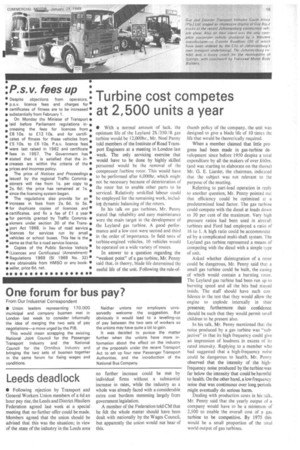Turbine cost competes at 2,500 units a year
Page 21

If you've noticed an error in this article please click here to report it so we can fix it.
• With a normal amount of luck. the optimum life of the Leyland 2S /350 /R gas turbine would be I 2,000hr., Mr. Noel Penny told members of the Institute of Road Transport Engineers at a meeting in London last week. The only servicing exercise that would have to be done by highly skilled personnel would be the removal of the compressor /turbine rotor. This would have to be performed after 6,000hr, which might not be necessary because of deterioration of the rotor but to enable other parts to be serviced. Relatively unskilled labour could be employed for the remaining work, including dynamic balancing of the rotors.
In his talk on gas turbines, Mr. Penny stated that reliability and easy maintenance were the main target in the development of the Leyland gas turbine. A good performance and a low cost were second and third in the order of importance. In field tests of turbine-engined vehicles, 10 vehicles would be operated on a wide variety of routes.
In answer to a question regarding the "weakest point" of a gas turbine, Mr. Penny said that, in theory, blade life determined the useful life of the unit. Following the rule-of
thumb policy of the company. the unit was designed to give a blade life of 10 times the life that would be theoretically required.
When a member claimed that little progress had been made in gas-turbine development since before 1950 despite a total expenditure by all the makers of over PiOni. (and was starting to elaborate on the theme) Mr. G. E. Liardet. the chairman, indicated that the subject was not relevant to the purpose of the meeting.
Referring to part-load operation in reply to another question, Mr. Penny pointed out that efficiency could be optimized at a predetermined load factor. The gas turbine could compete with the diesel at loads down to 30 per cent of the maximum. Very high pressure ratios had been used in aircraft turbines and Ford had employed a ratio of 16 to 1. A high ratio could be accommodated by a complicated multi-shaft system. The Leyland gas turbine represented a means of competing with the diesel with a simple type of unit.
Asked whether, disintegration of a rotor could be dangerous, Mr. Penny said that a small gas turbine could be built, the easing of which would contain a bursting rotor. The Leyland gas turbine had been run up to bursting speed and all the bits had stayed inside. The staff should have such confidence in the test that they would allow the engine to explode internally in their presence; furthermore their confidence should be such that they would permit small children to be present also.
In his talk, Mr. Penny mentioned that the noise produced by a gas turbine was "subjective" in that its high frequency could give an impression of loudness in excess or its rated intensity. Replying to a member who had suggested that a high frequencynoise could be dangerous to health, Mr. Penny observed that the intensity of the highfrequency noise produced by the turbine was far below the intensity that Could be harmful to health. On the other hand, a low frequency noise that was continuous over long periods might eventually do serious harm.
Dealing with production costs in his talk, Mr. Penny said that the yearly output of a company would have to be a minimum of 2,500 to enable the overall cost of a gas turbine to be competitive. By 1975 this would be a small proportion of the total world output of gas turbines.








































































































